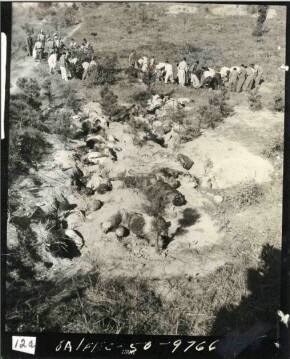hankyoreh
Links to other country sites 다른 나라 사이트 링크
TRCK confirms hundreds of villagers were massacred during onset of Korean War

It has been confirmed that several hundred villagers and members of the Bodo Yeonmaeng (National Guard Alliance), a “re-education” body where leftist sympathizers were assigned on the pretext of protecting them from execution, were in fact massacred by police and South Korean soldiers in the area around Yeongcheon, Gyeongsangbuk region over a two-month period at the start of the Korean War.
The Truth and Reconciliation Commission in South Korea (TRCK) handed down a decision on Monday confirming that at least 239 former leftists of the National Guard Alliance in the Yeongcheon area and villagers living near the Nakdonggang River front line were massacred en masse by police of Yeongcheon Police Station and troops stationed in the area between July and Sept. of 1950. The TRCK report states since the Yeongcheon area was a place of strategic importance, where North Korean and South Korean troops were engaged in hand-to-hand fighting, the alliance members were killed over a long period of time out of fear they might sympathize with North Koreans, unlike in other regions where alliance members were massacred at the start of the war.
The commission has determined that the Army pursued a deserter, Mr. Jeong, to Danji-ri in Hwasan-myeon and killed not only him and his family, but also 14 villagers with the same family name of Jeong. Another 50 villagers were massacred in Gujeon-ri in Hwanam-myeon, a village of the Hwangbo clan, and Donam-dong, Geumho-myeon (currently Yeongcheon City’s Donam-dong) solely because the land owner was supposedly a leftist activist and thus it was suspected that the villagers might be affected by the ideology of the land owner. These are a few cases in which the identities of the victims have been confirmed.
In early August, when the South Korean and North Korean armies formed a front line along the Nakdong River, the massacres reached a peak with an estimated 250 people being killed in the Ajakgol Valley of Imgo-myeon and the Beolbawi area of Jayang-myeon. An official from the TRCK says the number of victims whose identifications have been confirmed total 239, and when one adds those whose identities have not been confirmed, the number of victims is estimated at around 600.
The massacres were led by the army and police intelligence on orders from the Counter Intelligence Corps (CIC), a special operations unit. The TRCK says it has confirmed that U.S. counter-intelligence also knew about the massacres.
The TRCK is also saying that responsibility for the incident rests not just with the army and police, but also their superiors at the Martial Law Command, while ultimate responsibility rests with the state, which is supposed to manage and supervise the army and police. It is advising the state to officially apologize, support memorial projects, provide assistance to bereaved family members and provide peace and human rights training to army and police personnel.
Meanwhile, the TRCK as of the end of Sept. has completed its investigations of 1,638 out of 2,413 incidents regarding the National Guard Alliance, and is currently investigating the remaining 775 cases. The TRCK plans to conclude its investigation into the National Guard Alliance cases by the end of the year.
Please direct questions or comments to [englishhani@hani.co.kr]
Editorial・opinion
![[Column] Season 2 of special prosecutor probe may be coming to Korea soon [Column] Season 2 of special prosecutor probe may be coming to Korea soon](https://flexible.img.hani.co.kr/flexible/normal/500/300/imgdb/original/2024/0426/3317141030699447.jpg) [Column] Season 2 of special prosecutor probe may be coming to Korea soon
[Column] Season 2 of special prosecutor probe may be coming to Korea soon![[Column] Park Geun-hye déjà vu in Yoon Suk-yeol [Column] Park Geun-hye déjà vu in Yoon Suk-yeol](https://flexible.img.hani.co.kr/flexible/normal/500/300/imgdb/original/2024/0424/651713945113788.jpg) [Column] Park Geun-hye déjà vu in Yoon Suk-yeol
[Column] Park Geun-hye déjà vu in Yoon Suk-yeol- [Editorial] New weight of N. Korea’s nuclear threats makes dialogue all the more urgent
- [Guest essay] The real reason Korea’s new right wants to dub Rhee a founding father
- [Column] ‘Choson’: Is it time we start referring to N. Korea in its own terms?
- [Editorial] Japan’s rewriting of history with Korea has gone too far
- [Column] The president’s questionable capacity for dialogue
- [Column] Are chaebol firms just pizza pies for families to divvy up as they please?
- [Column] Has Korea, too, crossed the Rubicon on China?
- [Correspondent’s column] In Japan’s alliance with US, echoes of its past alliances with UK
Most viewed articles
- 1‘We must say no’: Seoul defense chief on Korean, USFK involvement in hypothetical Taiwan crisis
- 2[Editorial] Korea’s surprise Q1 growth requires objective assessment, not blind fanfare
- 3[Column] Season 2 of special prosecutor probe may be coming to Korea soon
- 4Division commander ordered troops to enter raging flood waters before Marine died, survivor says
- 5Is Japan about to snatch control of Line messenger from Korea’s Naver?
- 6The dream K-drama boyfriend stealing hearts and screens in Japan
- 7[Column] ‘Choson’: Is it time we start referring to N. Korea in its own terms?
- 8No good, very bad game for Korea puts it out of Olympics for first time since 1988
- 9[Special report- Part III] Curses, verbal abuse, and impossible quotas
- 10S. Korea “monitoring developments” after report of secret Chinese police station in Seoul